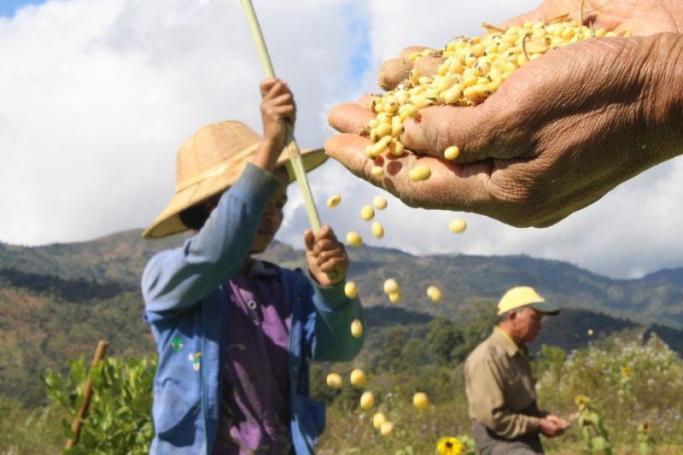Hla Min had been successfully farming soybean since 1994 on the hillsides of Shwe Pahtoe (South), an ethnic Danu village in Pindaya Township, southern Shan State, when around 2008 his harvests began to fall.
As rains became increasingly erratic due to a changing climate his crop suffered. Sometimes rains started unusually late and his plants would wither, or when he was about to reap his harvest it was flooded by a unseasonal downpour.
“After 2008, soybean cultivation became less successful because of climate change. Even outside the rainy season there is rain now,” the 52-year-old farmer said.
Like many small farmers in this region, where roughly a quarter of all of Myanmar’s soybean is grown, his bean harvest declined in quality and volume, putting pressure on his livelihood.
“I planted 1 acre of soybean in April 2016 and when I wanted to harvest in August, it rained the whole month and my harvest got wet,” Hla Min lamented during a recent interview in his village.
But now, a project to boost the resilience of the crop and improve its processing is under way in the region, and Hla Min said his confidence is rising again. Farmers are being trained how to improve cultivation, harvesting and processing of soybean, and they have been provided with flat-bed dryer technology to properly dry and store beans.
“As we have received modern harvest machine, we do not need to care about the rainfall during harvest anymore,” Hla Min said.
ADAPTING TO CLIMATE CHANGE
The USAID-funded project, implemented by US non-profit Winrock and local agriculture departments since 2014, is helping some 8,000 small farmers in seven southern Shan State townships to overcome challenges posed by weather conditions, falling soil fertility and limited domestic market access.
A project paper said it was introducing farmers to new seed varieties with varying growing-cycle lengths, new technology and modern storage methods. It also intends to support investment in local soybean processing for food, such as tofu factories, and strengthen marketing links between farmers, traders and food producers.
Thein Win, a director at Shan State’s Agricultural Department, said farmers would benefit from the introduction of soybean varieties with a shorter growing cycle, as it reduced the crop’s vulnerability to erratic weather.
“Suitable agricultural methods should be applied as climatic change is happing,” he said.
Hla Myo Zaw, another Danu farmer, said his 10 acres of soybean were affected by a torrential downpour last year, adding, however, that the new technology would also prevent rains from impacting his harvest.
“If we could reap and dry the rain-soaked seeds from the field immediately (and dry it with machines) we don’t need to worry about unseasonal rains,” he said.
STRONG DEMAND
Thet Swe, Winrock’s project manager, said the choice to support soybean was well-founded.
“Before the project started, we researched the market potential of 50 types of crops, but according to our researcher we find that soybean has the best market potential,” he said. “Soybean has a great market and many benefits for farmers.”
Domestic demand for soybean is growing in Myanmar, for both food production and as an input for animal feeder, while Chinese demand for soybean is strong, according to a soybean value chain assessment conducted for the project.
It notes that much of soybean goes to factories in Yangon, while a large share is exported to China through unregulated overland trade. Soybean is produced in Shan State and central Myanmar regions, where a total of some 50,000 acres is under cultivation at different times of year.
Aung San Win, a director of Global Veltex Company Ltd. in Taunggyi, which trades in various crops, said domestic demand for soybean was strong and prices were good.
“Local demand increases day by day. We have to import soybean from India to Myanmar to meet local demand,” he said, before adding that Chinese demand could offer higher prices for soybean but sales to China were being hampered by poor quality of harvested soybean.
“In this country, we cannot control soybean quality. The soybean is often moist, so they need to improve reaping the beans and process them systemically. Farmers are weak in making these improvements,” said Aung San Win, who also heads the Southern Shan State chapter of the Union of Myanmar Federation of Chambers of Commerce and Industry.
Thein Win, the agricultural department officer, said the commodities traders should work with the government and farmers on expanding domestic and export sales of soybean, and they should indicate what quality the markets desire.
“If the market demand gets higher, our department will work together with the farmers to ensure the right quality and quantity of crops,” he said.
Hla Myo Zaw, the farmer, said he was keen to expand with the new methods and technology, but added that farmers also need better access to capital, something they hope the government can provide through small loans.
“Soybean has a large market. I want to grow more, but we need both news method and low-interest loans,” he said.
You are viewing the old site.
Please update your bookmark to https://eng.mizzima.com.
Mizzima Weekly Magazine Issue...
14 December 2023
Spring Revolution Daily News f...
13 December 2023
New UK Burma sanctions welcome...
13 December 2023
Spring Revolution Daily News f...
12 December 2023
Spring Revolution Daily News f...
11 December 2023
Spring Revolution Daily News f...
08 December 2023
Spring Revolution Daily News f...
07 December 2023
Diaspora journalists increasin...
07 December 2023
Myanmar migrant workers arrested in Mae Sot












